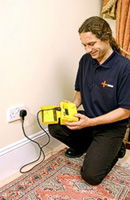From January 1st 2005, the new Part P of the Building Regulations, which concerns electrical safety in homes, came into effect. But Part P doesn’t just affect electrical installations in the home; it covers certain aspects of outdoor installations too, as Voltimum UK Managing Editor James Hunt points out.

Many homeowners today celebrate regular and special events with decorative outdoor lighting and, occasionally, for parties, will set up sound systems in their gardens. Electric barbecues are also becoming increasingly popular. These are all in addition to the mains-powered garden equipment, such as lawn mowers and hedge trimmers, which are now widely used. Such electrical equipment needs electrical power, of course, and gardens being naturally in an outdoor environment, this needs careful thought, not least for reasons of safety. Such issues are covered in other articles attached to this VoltiBULLETIN, but there’s also a new issue – that of Part P of the Building Regulations, and its impact on electrical installations, not only inside the home, but outside too.
Part P is having a significant impact on all electrical contractors and installers, not to mention DIYers, and all other involved in the design, installation and inspection of fixed electrical installations in homes. Part P, now well under way, is aimed at driving ‘cowboy electricians’ out of business, as well as protecting home owners from poor workmanship and making UK homes safer.
In a typical year, the records show that about 10 people die and 750 are seriously injured because of accidents resulting from dangerous electrical installations in the home. As The Office of the Deputy Prime Minister has commented: ‘much unsatisfactory electrical work is carried out by over ambitious amateurs’. Part P of the Building Regulations has been designed to address this problem and drive out those electricians and installers who, through ignorance or faulty design and workmanship, cause such accidents.
Part P relates to BS 7671 (the IEE Wiring Regulations). The idea is to enhance the electrical safety of domestic electrical installation work in England and Wales by bringing the work under the control of the Building Regulations. Failure to comply with Part P is a criminal offence and local authorities can enforce the alteration or removal of any installation work that does not meet the requirements.
It is thought that, prior to introduction of Part P, some 40,000 electrical contracting companies in England and Wales were not working to the previously existing voluntary controls. Now, with the advent of Part P, these companies are having to improve their work practices, and many have already done so - by 1st January 2005, the NICEIC reports, over 10,000 businesses, in total employing more than 20,000 operatives, had registered with the organisation’s Domestic Installer Scheme in order to be in a position to self-certify compliance with Part P.
The Electrical Contractors’ Association (ECA) has commented that electricians would face severe disruptions to their work if they hadn’t prepared for Part P, and that it is important that all businesses undertaking electrical work, in any role, understand the changes, plan for them and implement actions as a result. Many electricians have realised too late that they only had until January 1st 2005 to become registered as a ‘Competent Person’. That time is passed, but it is still not too late to become a ‘Competent Person’. If any electrical accident(s) occur in homes caused by electricians who are not yet ‘Competent Persons’, that’s another matter.
Part P’s scope – includes some outdoor installations:
Part P of the Building Regulations covers installations intended to operate at LV or ELV. These are:
- In a dwelling (houses or flats);
- Dwellings and business premises with a common supply (eg: shops or pubs with a flat above);
- Common access areas in blocks of flats (corridors & staircases);
- Shared amenities in blocks of flats (gymnasiums and laundries, but excluding lift power supplies):
- In or on land associated with the buildings (eg: fixed garden lighting and pond pumps); in outbuildings such as sheds, detached garages and greenhouses.
Therefore, electrical contractors and installers working on outdoor installations, including outdoor wiring accessory installation, should be ‘Competent Persons’, and should therefore be well versed in all aspects of outdoor electrical installation practise, especially if they are involved with it.